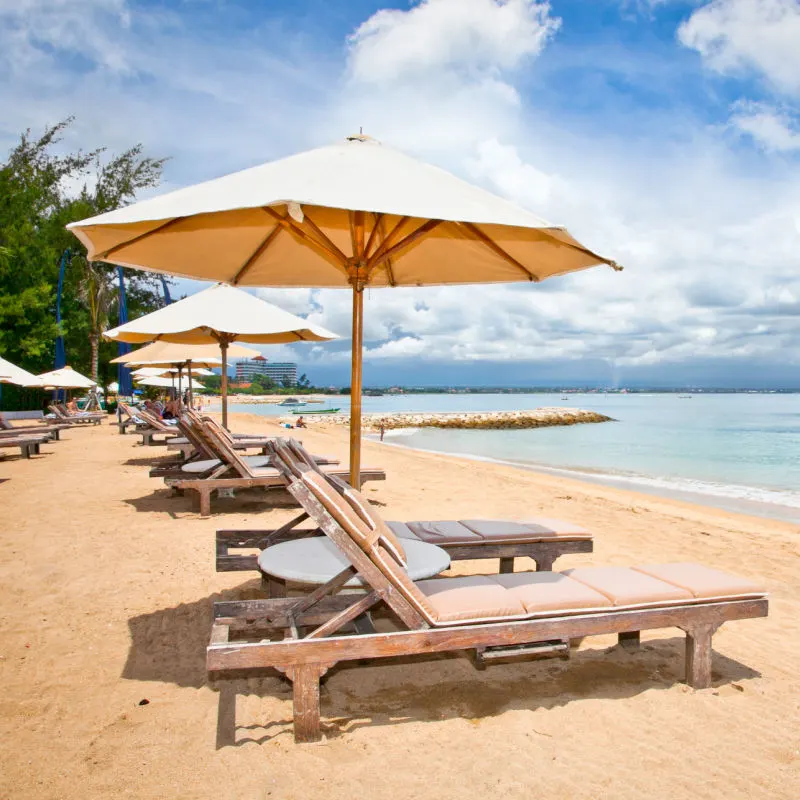Tourists heading to Sanur Beach in Bali are being warned about the season’s influx of bluebottle jellyfish. The poisonous jellyfish emerge in the waters off the southern coast of Bali on an annual basis.
The beach is still safe to visit, but tourists are being urged to be vigilant.

The Department of Fisheries and Food Security in Bali has issued a public appeal to anyone planning on visiting Sanur Beach.
There has been an influx of the poisonous bluebottle jellyfish over the last week and officials believe the marine life will be around for a while to come.
The Head of Denpasar City Fisheries and Food Security, Ida Baguds Mayun Suryawangsa, told reporters that the jellyfish have previously been seen in the waters off Sanur Beach between July and September.
He said, “this is a natural phenomenon because the strong wind brought this type of jellyfish to the beach.”
@shellcade What is your favourite sea animal!? #shellcade #ocean #bluebottle #jellyfish #seaanimals #oceanlife ♬ Blade Runner 2049 – Synthwave Goose
Suryawangsa and his teams are working with local fishing crews, coast guards, and beach management teams to monitor the presence of the jellyfish in the shallow waters where tourists swim and keep an eye if any are washed up on the shore.
Suryawangsa added, “We urge visitors to Sanur Beach to be more alert, avoid direct contact. If fishermen still find them, they can help clean the waters of Sanur Beach.”
@lewisjjc TOP 10 MUST DO on Sanur Beach, Bali 🇮🇩 • #sanur #sanurbeach #sanurbali #top10 #balitravel #reel #reelsvideo #fyp #travel #instatravel #baliindonesia #balitravel #bali🌴 #explorebali #youtube #vlog #lewisjjc ♬ Wave – Salmaun Hossain
The bluebottle jellyfish is commonly known in Australia as the Pacific (or Portuguese) man-o-war jellyfish. The creature has quite the reputation as being one of the most painful jellyfish stings in the world.
The stings are often intense and long-lasting. For anyone unfortunate enough to be stung by a bluebottle jellyfish there are a series of first aid steps to follow to help reduce pain and even risk of allergic reaction.
@1minuteanimals Portuguese Man O’ War 🌊 The Floating Terror Of The Ocean #portuguesemanowar #manowar #portuguesemanofwar #manofwar #physaliaphysalis ♬ original sound – 1 Minute Animals
According to Australian Wide First Aid, the first step in treating a bluebottle jellyfish sting is to ‘monitor the causality’ and offer comfort and reassurance.
The next step is to pick off any tentacles left on the skin, then remove any of the ‘invisible’ poisonous tentacles with salt water, such as ocean water.
Once the affected area is clear of any stinging tentacles, the area would be immersed in hot water or covered with hot running water for 20 minutes, more if possible.
The hot water helps kill the proteins in the venom that cause the painful stinging sensations.
If hot water is not available, then a dry ice pack can be used to offer pain relief until hot water can be accessed to help kill the venom.

The pain usually subsides within an hour if treatment is given quickly, though a red line usually remains where the tentacles have touched the skin.
In some cases, the contact site can become swollen and itchy and, in some instances, can even blister.

Urgent medical treatment must be sought in the event of an allergic reaction or if a young child or elderly person is stung.
There are several medical clinics in the Sanur area, and the new Bali International Hospital will be opening in early 2024.
Most resorts in the Sanur area have on-call doctors, nurses, and medical professionals to support their guests. The BIMC Hospital is a 33-minute drive from Sanur Beach.

So what should tourists look out for in the water? What does a bluebottle jellyfish look like?
The body of the jellyfish, known as the float, is shaped like a bottle or pear. They can be up to 15cm in size, though some are as small as 2cm in diameter, and are a light blue color.
The smaller ones can be tricky to see in the water, especially on days when the water is not so clear.
At the moment the warning is only issued for Sanur Beach and though the bluebottle jellyfish could be blown into shore anywhere from Sanur Beach through to the east.
Remove All Ads & Unlock All Articles… Sign up for The Bali Sun Premium

Plan Your Bali Holiday:
Book The Best English Speaking Drivers For Airport Transfers & Tours
Choose From Thousands of Bali Hotels, Resorts, and Hostels with Free Cancellation On Most Properties
Book Cheap Flights To Bali
Don’t Forget Travel Insurance That Covers Medical Expenses In Bali
For the latest Bali News & Debate Join our Facebook Community
SUBSCRIBE TO NEW POSTS
Enter your email address to subscribe to The Bali Sun’s latest breaking news, straight to your inbox.
Discover more from The Bali Sun
Subscribe to get the latest posts sent to your email.

Josh
Tuesday 19th of September 2023
These creatures prefer cooler waters so there must be slightly colder currents as well as winds bringing them in closer and more numerous here. There just was a particularly chillier winter southwards of these tropical realms this year.
Shorty
Thursday 21st of September 2023
@Josh, Josh they can't swim or self propel. They're completely at the vicissitudes of the wind, tides and ocean currents.
BaliDuck
Sunday 17th of September 2023
So what should tourists look out for on the beach? What does a bogan look like?
The body of the bogan, known as the float, is shaped like an apple. They can be up to XXXXL in size, though some are as small as XL cm in diameter, and are a light red color. Usually sitting in a plastic chair drinking bintang mumbling some rowdy words.
Exp
Monday 18th of September 2023
@BaliDuck, Do not forget the tatts acquired while drunk in some dodgy Kuta parlor
Ed Parks
Monday 18th of September 2023
@BaliDuck
That's funny dude. I can feel the love.
Exp
Saturday 16th of September 2023
TikTokers take note. After all in 2021 a TikToker posted a video of herself playing with a tiny cute octopus she came across in Bali: A blue ringed octopus: one of the world’s deadliest marine animals. Its venomous bite contains a deadly neurotoxin that is capable of causing respiratory arrest in a human in just minutes.
Shorty
Sunday 17th of September 2023
@Exp, Yes they're deadly dangerous little buggers. Fortunately they're shy. But some perspective. They're quite common in ocean rock pools in Australia. They've only been responsible for 3 reported deaths in the last 100 years. Since 1960 there's been 3 deaths worldwide. 2 of those come from those included in the Australian numbers, the other case was in Singapore.
Jim Craney
Saturday 16th of September 2023
I have heard that urinating on the sting will neutralise the venom. Is there any truth in this. I am asking seriously, not a joke.Terima kasih.
Shorty
Sunday 17th of September 2023
@Jim Craney, There's a small amount of truth.
By pissing on it you're helping to flush tentacles off the skin. Maybe, and a small maybe the warmth if the piss could help neutralise things. Nothing in urine has any effect/benefit.
Tho in reality you're at the beach. There's stacks of water to sluice the effected area.
James Bond
Sunday 17th of September 2023
@Jim Craney, yes, it is true.
Rick Novak
Saturday 16th of September 2023
Not mentioned were the two best remedies for blue bottle stings. Rub off the tentacles with sand and salt water when you get to the beach. And take an antihistamine like Benadryl for allergic reaction relief. A friend of mine almost died in Mexico once when he dove into a wave full of them…allergic reaction.
Shorty
Sunday 17th of September 2023
@Rick Novak, Attempting to rub off the tentacles will increase the pain/discomfort. You are forcing the 'barbs' deeper into the skin, and potentially making contact with more tentacles. BTW The ones pictured are not Portuguese Man of War. PMW are bigger, can have tentacles many metres long and stinging can be fatal.